
Among the Spitfire pilots who protected the Allied forces from the Luftwaffe during the evacuation at Dunkirk was Geoffrey Dalton Stephenson (above)
In the summer of 1940, a massive operation was underway to evacuate the British Army from the beaches and harbour at Dunkirk, France.
Hundreds of thousands of troops, including French and Belgians, had been cut off and were surrounded by the German army during the Battle of France.
Death or capture seemed the most likely outcome.
However, salvation would come during Operation Dynamo at the end of May that year, as dozens of 'little ships' crossed the English Channel to aid the evacuation process.
And among the brave pilots who protected the vessels - mainly private fishing or pleasure boats - and Allied forces from the Luftwaffe was Geoffrey Dalton Stephenson in his Spitfire.
The Commanding Officer of 19 Squadron at RAF Duxford, he was shot down in combat on May 26 while flying his Supermarine Spitfire MK1 N3200.
Stephenson had to ditch his plane after bullets hit the radiator - forcing him to crash-land on a beach at Sangatte, near Calais,
He was soon captured by the Germans and became a POW.

German soldiers inspect Stephenson's Supermarine Spitfire MK1 N3200 after it was shot down on a beach at Sangatte, near Calais on May 26, 1940. The British airman was captured and spent time as a POW at Colditz

Stephenson had to ditch his plane after enemy bullets hit the radiator - forcing him to crash-land during Operation Dynamo. Above, a Nazi sits in the Spitfire

Troops from the British Expeditionary Force wait in an orderly fashion to be evacuated during the Miracle of Dunkirk, which saw thousands of seaworthy vessels cross the Channel to bring the men back home
Stephenson tried and failed to escape several times, and was moved to Colditz Castle.
After the war, he continued to fly for the RAF and rose to the rank of Air Commodore.
RELATED ARTICLES
 Spitfire faithfully restored after 40 years buried under a...
Spitfire faithfully restored after 40 years buried under a...  German pilots? Our trigger-happy Dad's Army were just as big...
German pilots? Our trigger-happy Dad's Army were just as big... Designer of the iconic Spitfire thought the name was 'damned...
Designer of the iconic Spitfire thought the name was 'damned...
Share this article
ShareTragically, he died in November 1954, at the age of 44, while test flying a Super Sabre as part of an exchange trip with the US Air Force.
Meanwhile, his plane, became slowly buried under the sand.

Spitfires (above) were so feared by the Luftwaffe that many Nazi crews claimed to have been shot down by one when they had really been downed by the slower, more numerous, Hurricane

A Spitfire, flown by the former leader of the Red Arrows, buzzes a procession of little ships on its journey to Dunkirk in June 2000 to mark the 60th anniversary of the evacuation of British troops
NEMESIS OF THE NAZI AIRFORCE
More than 20,000 Spitfires were built in 24 different marks.
It first flew in the RAF in 1938 and was retired by 1957.
One of the proposed names for the fighter was 'The Shrew'.
Its designer RJ Mitchell only lived long enough to see the prototype fly in 1937.
The first plane shot down by a Spitfire was an RAF Hurricane in 1939 in a friendly fire incident known as the Battle of Barking Creek.
Spitfires were occasionally painted pink to blend in with the sunset and sunrise when used for low-level reconnaissance flights.
It was eventually recovered in 1986.
And today, Prince William travelled to the Imperial War Museum Duxford where he was presented with Stephenson's now fully restored Spitfire - gifted to the museum by American philanthropist Thomas Kaplan.
The aircraft was built in 1939 for the RAF at a Spitfire factory in Woolston, Southampton.
Together with the Hawker Hurricane, the Spitfires would play a crucial role in the Second World War, particularly during the Battle of Britain.
In fact, When Luftwaffe commander Hermann Göring asked his flying ace Adolf Galland what he needed to win the legendary 1940 air campaign, he replied: ‘A squadron of Spitfires.’
The plane was so feared by the Nazi airforce that many German crews claimed to have been shot down by one when they had really been downed by the slower, more numerous, Hurricane.

Today, Prince William travelled to the Imperial War Museum Duxford where he was presented with Stephenson's now fully restored Spitfire

The young royal stands by the Supermarine Spitfire MK 1 , gifted to the museum by American philanthropist Thomas Kaplan
ncG1vNJzZmivp6x7pa3IpbCmmZmhe6S7ja6iaKaVrMBwrdGtoJyklWKAcoGUa2ppZ4OltrWyyKucZquYpMFumNSfq7CZlpuybr7ErKuoqpWZe6nAzKU%3D